Congleton
| Congleton | |
|---|---|
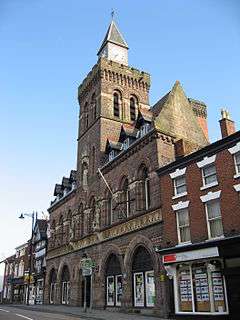 Congleton Town Hall, completed 1866 | |
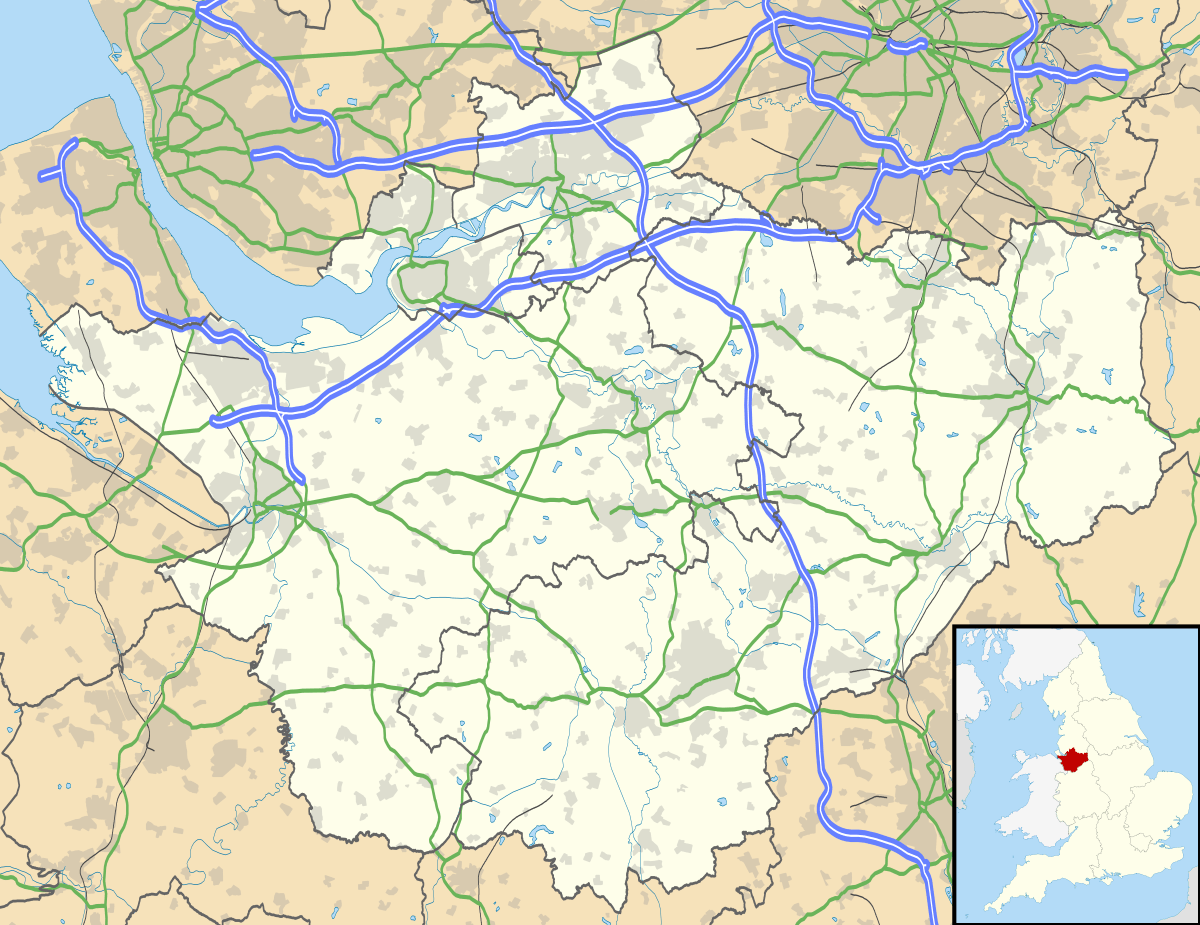 Congleton Congleton shown within Cheshire | |
| Population | 26,482 (2011) |
| OS grid reference | SJ854628 |
| Civil parish |
|
| Unitary authority | |
| Ceremonial county | |
| Region | |
| Country | England |
| Sovereign state | United Kingdom |
| Post town | CONGLETON |
| Postcode district | CW12 |
| Dialling code | 01260 |
| Police | Cheshire |
| Fire | Cheshire |
| Ambulance | North West |
| EU Parliament | North West England |
| UK Parliament | |
| Website |
www |
Congleton is a town and civil parish in the unitary authority of Cheshire East and the ceremonial county of Cheshire, England. It lies on the banks of the River Dane, 21 miles (34 km) south of Manchester and to the west of the Macclesfield Canal. At the 2011 Census, the parish had a population of 26,482.[1]
Toponymy
Of unknown origin, the first recorded reference to the town's name was in 1282, when it was spelt Congelton. The element Congle could relate to the old Norse kang meaning a bend followed by the element the Old English tun meaning settlement.[2]
History
The first settlements in the Congleton area were Neolithic. Stone Age and Bronze Age artefacts have been found in the town.[3] Congleton was once thought to have been a Roman settlement, although there is no archaeological or documentary evidence to support this. Congleton became a market town after Vikings destroyed nearby Davenport.
Godwin, Earl of Wessex held the town in the Saxon period. The town is mentioned in the Domesday Book,[4] where it is listed as Cogeltone: Bigot de Loges. William the Conqueror granted the whole of Cheshire to his nephew the Earl of Chester who constructed several fortifications including the town's castle in 1208. In the 13th century, Congleton belonged to the de Lacy family.[3] Henry de Lacy, 3rd Earl of Lincoln granted the town its first charter in 1272, enabling it to hold fairs and markets, elect a mayor and ale taster, have a merchant guild and behead known criminals.[3]
In 1451, the River Dane flooded, destroying a number of buildings, the town's mill and wooden bridge.[3] The river was diverted and the town rebuilt on higher ground.
Congleton became notorious in the 1620s when bear-baiting, as well as cockfighting, were popular sports.[3] The town was unable to attract large crowds to its bear-baiting contests and lacked the money to pay for a new, more aggressive bear. The town used money it had saved to buy a Bible and it replenished the fund with the income from the increased number of spectators. It became legend that Congleton sold its Bible to pay for a new bear. The chorus of 20th-century folk song "Congleton Bear",[5] by folk artist John Tams,[6] runs:
- Congleton Rare, Congleton Rare
- Sold the Bible to buy a bear.
The legend earned Congleton the nickname 'Beartown'.
During the Civil War, former mayor and lawyer, John Bradshaw, became president of the court which sent Charles I to his execution in 1649. His signature as Attorney General was the first on the king's death warrant.[3] A plaque on Bradshaw House in Lawton Street commemorates him. Almost opposite the town hall, the White Lion public house bears a blue plaque, placed by the Congleton Civic Society, which reads: "The White Lion, built 16–17th century. Said to have housed the attorney's office where John Bradshaw, regicide, served his articles."[7]
_in_1902.png)
King Edward I granted permission to build a mill. Congleton became an important centre of textile production, especially leather gloves and lace.[3] Congleton had an early silk throwing mill, the Old Mill built by John Clayton and Nathaniel Pattison in 1753.[8] More mills followed, and cotton was also spun. The town's prosperity depended on tariffs imposed on imported silk. When tariffs were removed in the 1860s, the empty mills were converted to fustian cutting. A limited silk ribbon weaving industry survived into the 20th century, and woven labels were still produced in the 1990s. Many mills survive as industrial or residential units.[9]
The town hall was designed, in the Gothic style, by Edward William Godwin. It was completed in 1866.[10]
Governance
Congleton forms the central portion of the Cheshire East unitary authority, located in the south-east of Cheshire. Before the abolition of Cheshire County Council on 1 April 2009, Congleton had borough status (originally conferred in 1272). The neighbouring village of Buglawton was incorporated into Congleton borough in 1936. From 1974 to 2009, Congleton borough covered much of south-east Cheshire.
For representation on Cheshire East Council, Congleton divided into two wards returning three members, Congleton East and Congleton West. All six seats are currently represented by Conservative Party Councillors.[11]
The town has an elected Town Council[12] which was established in 1980. The town is split into two wards with 20 councillors elected every 4 years.
The Congleton parliamentary constituency is a county constituency represented in the House of Commons of the Parliament of the United Kingdom. It includes the towns of Congleton, Alsager, Holmes Chapel, Middlewich and Sandbach. It elects one Member of Parliament (MP) by the first-past-the-post system of election. The current MP is Fiona Bruce of the Conservative Party — the constituency has always been a safe Conservative seat. The previous incumbent was Anne Winterton, who sat in parliament alongside her husband Nicholas Winterton, the MP for neighbouring Macclesfield. After they were judged to have broken MPs' expense rules in 2008 by claiming for rent on a second home owned by a family trust, both stood down at the 2010 general election; their joint statement cited the hectic life of politics as part of their reason for standing down.[13]
Geography
Mossley is sometimes classed as the wealthier part of town. Hightown is located before Mossley between town and the railway station. West Heath is a relatively new estate built in the early 1960s to the early 1980s. Lower Heath lies to the north of the town. There is also the town centre.
In terms of physical geography, Congleton is located in the valley of the River Dane. To the south of the town lies an expanse of green space known locally as Priesty Fields which forms a green corridor right into the heart of the town – a rare feature in English towns.
Economy
The principal industries in Congleton include the manufacture of airbags and golf balls. There are light engineering factories near the town, and sand extraction occurs on the Cheshire Plain, although much of the town is now a dormitory for Manchester and Stoke-on-Trent.
Congleton Market operates every Tuesday and Saturday from the Bridestones Centre.
Culture and sport
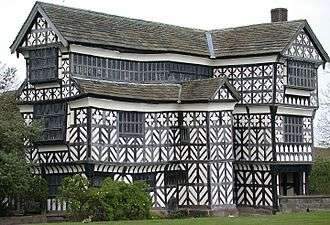
The National Trust Tudor house Little Moreton Hall is four miles (6.4 km) southwest of the town.[14]
Congleton is home to one of the oldest recorded rugby union clubs in the country, dating back to 1860, although there have been periods when the club were not able to field a side. Currently fielding a mini and junior section and two adult sides,[15] the club holds the world record for the longest continuous game of rugby ever played; at 24 hours, 30 minutes and 6 seconds.
There is also a local football team, Congleton Town F.C., known as the Bears, who play in the North West Counties League. Their ground is at Booth Street. There are also two cricket clubs, Congleton CC and Mossley CC. There are two golf clubs in the town; the historic Congleton Golf Club which is an undulating nine-hole course with views over the Cloud End, and the 18-hole parkland course at Astbury. There is also a running club, Congleton Harriers, which meets weekly at Congleton Leisure Centre.[16] The club organises the Congleton Half Marathon[17] and in 2012 re-introduced the Congleton Quarter Marathon.
Congleton Park is located along the banks of the River Dane just north east of the town centre. Town Wood on the northern edge of the park is a Grade A Site of Biological Interest and contains many nationally important plants.[18] Congleton Paddling Pool was built in the 1930s and is open in the summer months. Astbury Mere Country Park lies just to the south west of the town centre, on the site of a former sand quarry.[19][20] The lake is used for fishing and sailing and despite its name, is actually in the West Heath area of Congleton, with the boundary between Congleton and Newbold Astbury parishes lying further to the south.
The independently-run 300 seat Daneside Theatre is on Park Road. The 400-seat Clonter Opera Theatre is based in the village of Swettenham Heath, 5 mi (8 km) north of Congleton. Founded in 1971, Congleton Choral Society is a mixed voice choir which regularly performs choral works at Congleton Town Hall and other venues around the town
Congleton Museum is on Market Square in the centre of town. It was established in 2002 and is dedicated to Congleton's industrial history. It also contains an ancient log boat and gold and silver coin hoards.[21] Congleton Tourist Information Centre is on the town's High Street.
The town also annually hosts a food and drink festival[22] promoting locally sourced produce/cuisine and a jazz and blues festival which showcases acts from across the UK.
Media
There is one weekly local newspaper: the locally owned paid-for Congleton Chronicle. The evening newspaper The Sentinel, based in Stoke-on-Trent, also covers the town, although less so than in the past. Local radio is broadcast from nearby Macclesfield-based Silk FM, Signal 1 and Signal 2 from Stoke-on-Trent and BBC Radio Stoke, as well as Moorlands Radio in Leek and Canalside Community Radio in Macclesfield, both community radio stations. Congleton did have its own community radio station, the internet-only Beartown Radio, but this has now closed.
Transport and infrastructure

Congleton is seven miles (11 km) east of the M6 motorway, connected by the A534. It is on the A34 trunk road between Stoke-on-Trent and Manchester, and the A54 to Buxton and the Peak District. The A536 links the town with Macclesfield, with the A527 linking the town to Biddulph and providing an alternative route to Stoke-on-Trent.
Congleton railway station opened on 9 October 1848. It lies on the Manchester to Stoke-on-Trent branch of the West Coast Main Line. It was revealed in The Sentinel newspaper on 7 September 2011[23] that the ticket office could be closed as part of Government budget cuts.
The Macclesfield Canal, completed in 1831, passes through the town. It runs 26 miles (42 km) from Marple Junction at Marple, where it joins the Upper Peak Forest Canal, southwards (through Bollington and Macclesfield), before arriving at Bosley. Having descended the 12 Bosley Locks over the course of about a mile (1.6 km), the canal continues through Congleton to a junction with the Hall Green Branch of the Trent & Mersey Canal at Hall Green. The canal is renowned for its elegant roving bridges, locally known as 'Snaily Bridges'. Congleton is one of few places in Britain where a road, canal and railway all cross each other at the same place. The nearest airport to the town is Manchester Airport, 20 mi (32 km) away.
Infrastructure
Policing in Congleton is provided by Cheshire Constabulary. The main police station is on Market Square.
Statutory emergency fire and rescue service is provided by the Cheshire Fire and Rescue Service. Congleton Fire Station is on West Road, near the centre of town.
Congleton has a small hospital, Congleton War Memorial Hospital, which was built by public subscription in 1924. The town is also served by Leighton Hospital in Crewe, Macclesfield District General Hospital and the University Hospital of North Staffordshire in Stoke-on-Trent.
Utility firm United Utilities manages Congleton's drinking and waste water.
Religion
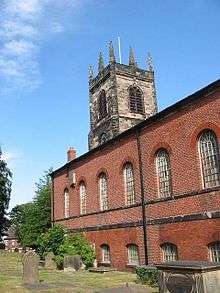
The four Anglican churches in Congleton are St John's, St Stephen's, St Peter's and Holy Trinity. They form a partnership in the Congleton Team Parish.[24] Congleton Town Council lists eleven other places of worship in the town:[25]
- Congleton Community Baptist Church[26]
- Brookhouse Green [Methodist] Church[27]
- New Life Church[28]
- Congleton Pentecostal Church[29]
- Rood Lane Methodist Church
- Spiritualist Church[30]
- St James' Anglican Church
- St Mary's Roman Catholic Church[31]
- Trinity Methodist Church
- Congleton United Reformed Church[32]
- Wellspring Methodist Church
- The Church of Jesus Christ of Latter-day Saints (Mormons)
Historically Congleton has seen a wide range of Christian church denominations.
The Friends' Meeting House closed in 1741.[33]
The Wesleyan Methodist Trinity Chapel, in Wagg Street, was founded in 1766 and was rebuilt in 1808 and again in 1967; the Primitive Methodist Chapel was built in 1821 on Lawton Street, and rebuilt in 1890 on Kinsey Street; the Countess of Huntingdon's Connexion Methodist chapel was founded in 1822; the Congleton Edge Wesleyan Methodist Chapel was built in 1833 and rebuilt in 1889; the Wesleyan Methodist Chapel in Brook Street was built in 1834; the New Connexion Methodist Chapel in Queen Street was built in 1836 and closed in 1969; the Primitive Methodist Chapel in Biddulph Road was built in 1840; the Wesleyan Methodist Chapel in Rood Lane was founded in 1861 and rebuilt in 1886.[33]
The Unitarian Chapel in Cross Street was founded in 1687 near the Dane Bridge and in 1733 moved to Cross Street, with the present building constructed in 1883 and closed in 1978. The United Reformed Church (Independent/ Congregationalist) was built in 1790 on Mill Street, and then rebuilt in 1876 on Antrobus Street.[33]
Education
Primary schools
- Astbury St Mary's C of E School
- Black Firs Primary School
- Buglawton Primary School
- Daven Primary School
- Havannah Primary School
- Marlfields Primary School
- Mossley C of E Primary School
- Smallwood C of E Primary School
- St Mary's RC Primary School
- The Quinta Primary School
High and secondary schools
- Buglawton Hall (closed 2018)
- Congleton High School
- Eaton Bank Academy
Notable people


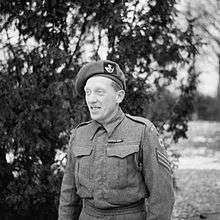

.jpg)
- Saint Margaret Ward (died 1588), the "pearl of Tyburn", English Catholic martyr[34] executed during the reign of Elizabeth I for assisting a priest to escape from prison
- John Bradshaw (1602–1659), judge,[35] sat as President of the High Court of Justice for the trial of King Charles I, Mayor of Congleton 1637–1638
- John Whitehurst FRS (1713–1788), clockmaker[36] and scientist, member of the Lunar Society
- Sir John Parnell, 2nd Baronet (1744–1801), Anglo-Irish Member of Parliament,[37] his family originally migrated to Ireland from Congleton
- Gibbs Crawfurd Antrobus (1793–1861), diplomat and politician,[38] long-established family in Congleton
- Hewett Watson (1804–1881), phrenologist,[39] botanist and evolutionary theorist
- William Newton (1822–1876), trade unionist, journalist and Chartist
- Elizabeth Clarke Wolstenholme Elmy (1833–1918), suffragist, essayist and poet
- Rear-Admiral Gerald Cartmell Harrison (1883–1943), Royal Navy officer[40] and cricketer[41]
- Captain Percy Wilson MC (born Congleton, 1895; date of death unknown), World War I[42] flying ace
- Theodora Turner OBE ARRC (1907–1999), born in Congleton, nurse[43] and hospital matron.
- Frank Kearton, Baron Kearton OBE FRS FRSA (1911–1992), life peer, scientist and industrialist
- George Harold Eardley VC MM (1912–1991), received the Victoria Cross[44] in 1944[45]
- Ann Winterton (born 1941), politician, MP[46] for Congleton 1983–2010
- John Blundell (1952–2014), Director General[47] at the Institute of Economic Affairs
- Dawn Gibbins MBE, entrepreneur,[48] started flooring company Flowcrete with her late father
Arts
- Stanley Unwin (1911–2002), also "Professor" Stanley Unwin, comedian,[49] actor and comic
- Alan Garner OBE (born 1934), novelist[50] best known for his children's fantasy novels
- William Ralph Turner, (1920–2013), painter
- Louise Plowright (1956–2016), actress[51]
- Mark Edwardson (born 1967), TV presenter, BBC North West lives in Congleton
- Paul Franklin (born 1966), visual effects supervisor,[52] Academy Award and BAFTA winner for Inception and Interstellar
- Emma Bossons (born 1976 in Congleton), ceramic artist and designer for Moorcroft Pottery
- Rachel Egglestone-Evans (born 1980), publisher and editor of Vintage Life magazine
- Jackie Oates (born in Congleton in 1983), folk singer and fiddle player
Sports
- Tommy Clare (1865–1929), international footballer (right-back) and football manager[53]
- George Clawley (1875–1920), professional goalkeeper who played for Stoke City F.C., Southampton and Tottenham Hotspur
- Bill Fielding (1915–2006), goalkeeper for Cardiff City, Bolton Wanderers and Manchester United
- Ann Packer (born 1942) and Robbie Brightwell (born 1939), husband-and-wife Olympic Gold Medal athletes
- Ian Brightwell (born 1968), former Manchester City footballer and England U-21 international; grew up in Congleton
- Laura Newton (born 1977), cricketer[54]
- Daniel Sturridge (born 1989), Liverpool footballer[55] and England international
Gallery
- Congleton
 Bluebells at Dane-in-Shaw Brook SSI.
Bluebells at Dane-in-Shaw Brook SSI. Astbury Mere
Astbury Mere
See also
References
- ↑ "Congleton (Parish): Key Figures for 2011 Census". Neighbourhood Statistics. Office for National Statistics. Retrieved 13 March 2016.
- ↑ Ekwall, Eilert (1936). The Concise Oxford Dictionary of English Place-Names (Fourth, 1984 Reprint ed.). Oxford. p. 120. ISBN 0-19-869103-3.
- 1 2 3 4 5 6 7 "Congleton Museum website". Archived from the original on 21 July 2011. Retrieved 7 October 2010.
- ↑ "The Domesday Book Online". Retrieved 7 October 2010.
- ↑ "Congleton Bear Lyrics". Archived from the original on 30 September 2007. Retrieved 9 August 2007.
- ↑ "John Tams information". Archived from the original on 19 August 2007. Retrieved 9 August 2007.
- ↑ "Photographs of Congleton, Cheshire, England, UK". www.thornber.net. Retrieved 12 October 2018.
- ↑ Callandine, Anthony (1993). "Lombe's Mill: An Exercise in reconstruction". Industrial Archaeology Review. Maney Publishing. XVI (1). ISSN 0309-0728.
- ↑ Fustian Mills Talk Archived 3 April 2015 at the Wayback Machine. Lyndon Murgatroyd 2007
- ↑ "Town Hall" at congleton-tc.gov.uk
- ↑ "Your Councillors". 12 October 2018. Retrieved 12 October 2018.
- ↑ "Town Council". Archived from the original on 13 February 2012. Retrieved 10 September 2011.
- ↑ "MP pair to step down at election". BBC News. 25 May 2009. Retrieved 8 May 2010.
- ↑ "Sentinel newspaper article". Retrieved 9 August 2007.
- ↑ "Teams". Congleton RUFC. Retrieved 20 December 2016.
- ↑ "About Us". Congleton Harriers. Retrieved 20 December 2016.
- ↑ "Congleton Half Marathon". Congleton Harriers. Retrieved 20 December 2016.
- ↑ "Welcome to South East Cheshire website".
- ↑ "Astbury Mere Country Park". www.alsager.com. Retrieved 12 October 2018.
- ↑ "Cheshire East Council – Astbury Mere Country Park". Retrieved 12 October 2018.
- ↑ "Congleton Museum website".
- ↑ "Congleton Food and Drink Festival". Retrieved 10 February 2016.
- ↑ "Kidsgrove, Congleton and Sandbach railway ticket offices on hit-list - This is Staffordshire". Retrieved 12 October 2018.
- ↑ "Welcome to Congleton Team Parish". Retrieved 12 January 2013.
- ↑ "Places of Worship". Archived from the original on 4 January 2013. Retrieved 12 January 2013.
- ↑ "Congelton Baptist Church". Retrieved 12 January 2013.
- ↑ "The Methodist Church – Dane and Trent Circuit". Retrieved 13 January 2013.
- ↑ "New Life Church". Retrieved 13 January 2013.
- ↑ "Cross Street". Retrieved 13 January 2013.
- ↑ "Congleton Spiritualist Church". 2011. Archived from the original on 28 August 2012. Retrieved 13 January 2013.
- ↑ "St Mary R C Church". St Mary R C Church. Retrieved 12 October 2018.
- ↑ "Minshull Vernon United Reformed Church". 2013. Retrieved 13 January 2013.
- 1 2 3 "Congleton". genuki. 1996–2012. Retrieved 13 January 2013.
- ↑ Catholic Encyclopedia, St. Margaret Ward retrieved December 2017
- ↑ Dictionary of National Biography, 1885–1900, Volume 06, Bradshaw, John (1602–1659) retrieved December 2017
- ↑ Dictionary of National Biography, 1885–1900, Volume 61, Whitehurst, John retrieved December 2017
- ↑ The History of Parliament Trust, PARNELL, Sir John, 2nd Bt. (1744–1801), of Rathleague, Queen's Co retrieved December 2017
- ↑ The History of Parliament Trust, ANTROBUS, Gibbs Crawfurd (1793–1861), of Eaton Hall, nr. Congleton, Cheshire) retrieved December 2017
- ↑ Dictionary of National Biography, 1885–1900, Volume 60, Watson, Hewett Cottrell retrieved December 2017
- ↑ The National Archives, ref ADM 196/48/164 retrieved December 2017
- ↑ ESPN cricinfo Database retrieved December 2017
- ↑ The Aerodrome, Lt.(T./Capt.) Percy Wilson, R.A.F. retrieved December 2017
- ↑ The Independent, Obituaries: Theodora Turner, 31 August 1999 retrieved December 2017
- ↑ The London Gazette, Publication date:29 December 1944, Supplement:36870, Page:139 retrieved December 2017
- ↑ George Harold Eardley Archived 27 May 2012 at the Wayback Machine.
- ↑ BBC News Channel, 26 February, 2004 Ann Winterton: A 'family values' Tory retrieved December 2017
- ↑ ATLAS NETWORK, 22 July 2014, IN MEMORIAM: JOHN BLUNDELL (1952–2014) retrieved December 2017
- ↑ Daily Record, 7 JAN 2011 retrieved December 2017
- ↑ IMDb Database retrieved December 2017
- ↑ IMDb Database retrieved December 2017
- ↑ IMDb Database retrieved December 2017
- ↑ IMDb Database retrieved December 2017
- ↑ SoccerBase Database retrieved December 2017
- ↑ ESPN cricinfo Database retrieved December 2017
- ↑ SoccerBase Database retrieved December 2017
Sources
- Head, Robert (1887). Congleton Past and Present. Robert Head.
External links
| Wikimedia Commons has media related to Congleton. |
- Congleton Town Council website

- Welcome to Congleton — dedicated tourism website for the Congleton area.
- Congleton website — Congleton's history and Congleton of the present day
- Congleton Museum — local history museum and education resource